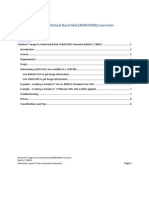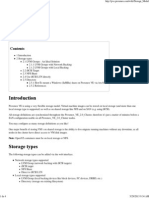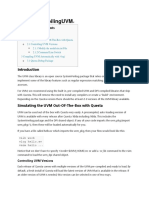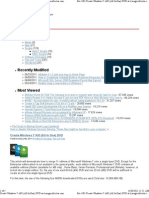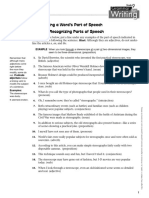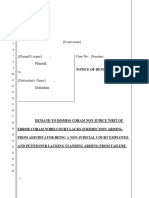Wimexport
Wimexport
Uploaded by
julio Cesar Valladares DelgadoCopyright:
Available Formats
Wimexport
Wimexport
Uploaded by
julio Cesar Valladares DelgadoOriginal Title
Copyright
Available Formats
Share this document
Did you find this document useful?
Is this content inappropriate?
Copyright:
Available Formats
Wimexport
Wimexport
Uploaded by
julio Cesar Valladares DelgadoCopyright:
Available Formats
WIMEXPORT(1) User Commands WIMEXPORT(1)
NAME
wimexport − Export image(s) from a WIM archive
SYNOPSIS
wimexport SRC_WIMFILE SRC_IMAGE DEST_WIMFILE
[DEST_IMAGE_NAME [DEST_IMAGE_DESC]] [OPTION...]
DESCRIPTION
wimexport, or equivalently wimlib-imagex export, exports the specified image from SRC_WIMFILE into
DEST_WIMFILE, optionally changing the image’s name and/or description. If DEST_WIMFILE already
exists, the image will be appended to it; otherwise, a new WIM archive will be created to contain the
exported image.
SRC_IMAGE specifies the image in SRC_WIMFILE to export. It may be the 1-based index of an image,
the name of an image, or the keyword "all" to specify all images. You can use wiminfo(1) to list the
images contained in SRC_WIMFILE.
If specified, DEST_IMAGE_NAME is the name to give the image being exported. The default is its name in
SRC_WIMFILE. If specified, DEST_IMAGE_NAME must be either a name not already used in
DEST_WIMFILE, or the empty string to leave the image unnamed. DEST_IMAGE_NAME cannot be speci-
fied if "all" images are being exported.
If specified, DEST_IMAGE_DESC is the description to give the image being exported. The default is its
description in SRC_WIMFILE.
wimexport supports exporting images from stand-alone WIMs as well as from split WIMs and delta
WIMs. See SPLIT WIMS.
wimexport also supports exporting images from a non-pipable WIM into a pipable WIM or vice versa, or
from a non-solid WIM into a solid WIM or vice versa. It can also export a pipable WIM directly to stan-
dard output if DEST_WIMFILE is specified as "-"; see --pipable.
OPTIONS
--boot
Mark the exported image as the "bootable" image of the WIM; or, if multiple images are being
exported, make the image that was the bootable image of the source WIM also the bootable image
of the destination WIM.
--check
Before exporting the image(s), verify the integrity of the source and destination WIMs if extra
integrity information is present. Also include extra integrity information in the destination WIM,
even if it was not present before.
--nocheck
Do not include extra integrity information in the destination WIM, even if it was present before.
--compress=TYPE[:LEVEL]
Specify the compression type, and optionally the compression level for that compression type, for
DEST_WIMFILE. Note that if DEST_WIMFILE already exists, then its compression type cannot be
changed by this option. See the documentation for this option to wimcapture(1) for more details.
--chunk-size=SIZE
Set the WIM compression chunk size to SIZE. See the documentation for this option to wimcap-
ture(1) for more details.
--recompress
Force all exported data to be recompressed, even if the destination WIM will use the same compres-
sion type as the source WIM.
--solid
Create a "solid" archive that compresses multiple files together. This usually results in a signifi-
cantly better compression ratio but has disadvantages such as reduced compatibility. See the docu-
mentation for this option to wimcapture(1) for more details.
wimlib 1.11.0 January 2017 1
WIMEXPORT(1) User Commands WIMEXPORT(1)
--solid-compress=TYPE[:LEVEL]
Like --compress, but set the compression type used in solid resources. See the documentation for
this option to wimcapture(1) for more details.
--solid-chunk-size=SIZE
Like --chunk-size, but set the chunk size used in solid resources. See the documentation for this
option to wimcapture(1) for more details.
--threads=NUM_THREADS
Number of threads to use for compressing data. Default: autodetect (number of processors).
--rebuild
If exporting to an existing WIM, rebuild it rather than appending to it. Rebuilding is slower but will
save some space that would otherwise be left as a hole in the WIM. Also see wimoptimize(1).
--ref="GLOB"
File glob of additional WIMs or split WIM parts to reference resources from. See SPLIT_WIMS.
This option can be specified multiple times. Note: GLOB is listed in quotes because it is interpreted
by wimexport and may need to be quoted to protect against shell expansion.
--pipable
Build or rebuild DEST_WIMFILE as a "pipable WIM" that can be applied fully sequentially, includ-
ing from a pipe. See wimcapture(1) for more details about creating pipable WIMs. The default
without this option is to make DEST_WIMFILE pipable only if it was "-" (standard output) or was
an existing pipable WIM.
--not-pipable
Rebuild DEST_WIMFILE as a normal, non-pipable WIM. This only useful if you are exporting
image(s) to a pipable WIM but you want it rebuilt as non-pipable.
--wimboot
Mark the destination image as WIMBoot-compatible. Also, if exporting to a new archive, set the
compression type to that recommended for WIMBoot (currently, XPRESS with 4096 byte chunks).
--unsafe-compact
Compact the existing destination WIM in-place and append any new data, eliminating "holes". This
is efficient, but in general this option should not be used because a failed or interrupted compaction
will corrupt the WIM archive. For more information, see the documentation for this option to
wimoptimize(1).
SPLIT WIMS
You may use wimexport to export images from (but not to) a split WIM. The SRC_WIMFILE argument
must specify the first part of the split WIM, while the additional parts of the split WIM must be specified in
one or more --ref="GLOB" options. Since globbing is built into the --ref option, typically only one --ref
option is necessary. For example, the names for the split WIM parts usually go something like:
mywim.swm
mywim2.swm
mywim3.swm
mywim4.swm
mywim5.swm
To export the first image of this split WIM to a new or existing WIM file
"other.wim", run:
wimexport mywim.swm 1 other.wim --ref="mywim*.swm"
NOTES
Data consistency: Except when using --unsafe-compact, it is safe to abort a wimexport command partway
through. However, after doing this, it is recommended to run wimoptimize on the destination WIM to
remove any data that was appended to the physical WIM file but not yet incorporated into the structure of
the WIM, unless the WIM was being rebuilt (e.g. with --rebuild), in which case you should delete the
wimlib 1.11.0 January 2017 2
WIMEXPORT(1) User Commands WIMEXPORT(1)
temporary file left over.
Data deduplication: The WIM format has built-in deduplication (also called "single instancing") of file
contents. Therefore, when an image is exported, only the file contents not already present in the destination
WIM will be physically copied. However, a new copy of the image’s metadata resource, which describes
the image’s directory structure, will always be created.
ESD files: wimexport supports solid-compressed WIMs, or "ESD" (.esd) files, except for encrypted ESDs,
which must be decrypted first. The source and destination files of wimexport can be solid WIMs, non-
solid WIMs, or a combination thereof. If the destination file does not exist, then by default it will be cre-
ated as solid if the source was solid, or as non-solid if the source was non-solid. To override this, either
specify --solid to create a solid WIM (.esd file), or specify --compress=LZX to create a standard non-solid
WIM (.wim file).
EXAMPLES
Export the second image of ’boot.wim’ to the new WIM file ’new.wim’:
wimexport boot.wim 2 new.wim
The above example creates "new.wim" with the same compression type as "boot.wim". If you wish to
change the compression type, specify --compress=TYPE; for example:
wimexport boot.wim 2 new.wim --compress=LZX
Export "ESD to WIM" --- that is, solid WIM to non-solid WIM:
wimexport install.esd all install.wim --compress=LZX
Export "WIM to ESD" --- that is, non-solid WIM to solid WIM:
wimexport install.wim all install.esd --solid
SEE ALSO
wimlib-imagex(1) wiminfo(1) wimoptimize(1)
wimlib 1.11.0 January 2017 3
You might also like
- Workshop Manual: 200 200LC 210H 210LCH 210K 210LCK100% (1)Workshop Manual: 200 200LC 210H 210LCH 210K 210LCK10 pages
- Name Synopsis Description: Wimupdate WIMFILENo ratings yetName Synopsis Description: Wimupdate WIMFILE4 pages
- Name Synopsis Description: Wimlib-Imagex Dir WIMFILE IMAGE (OPTIONS)No ratings yetName Synopsis Description: Wimlib-Imagex Dir WIMFILE IMAGE (OPTIONS)1 page
- Name Synopsis Description: Wimapply WIMFILENo ratings yetName Synopsis Description: Wimapply WIMFILE6 pages
- Name Synopsis Description: Wimextract WIMFILE IMAGENo ratings yetName Synopsis Description: Wimextract WIMFILE IMAGE3 pages
- Name Synopsis Description: Wimlib-Imagex Split WIMFILE SPLIT - WIM - PART - 1 PART - SIZE (OPTION... )No ratings yetName Synopsis Description: Wimlib-Imagex Split WIMFILE SPLIT - WIM - PART - 1 PART - SIZE (OPTION... )1 page
- Windows® Image To Virtual Hard Disk (WIM2VHD) Converter Build 6.1.7600.0No ratings yetWindows® Image To Virtual Hard Disk (WIM2VHD) Converter Build 6.1.7600.09 pages
- Adding Drivers To A Custom winPE With WAIKNo ratings yetAdding Drivers To A Custom winPE With WAIK4 pages
- Creating A Custom VIB: Install The Vibauthor ToolNo ratings yetCreating A Custom VIB: Install The Vibauthor Tool5 pages
- UNIT 37: Making Movies: Effective Casting SimulationNo ratings yetUNIT 37: Making Movies: Effective Casting Simulation70 pages
- Notes For WebSphere8.5 Administration Udemy v1No ratings yetNotes For WebSphere8.5 Administration Udemy v130 pages
- My Interview Questions and Answers For JobNo ratings yetMy Interview Questions and Answers For Job78 pages
- VisualSFM - A Visual Structure From Motion System - DocumentationNo ratings yetVisualSFM - A Visual Structure From Motion System - Documentation14 pages
- Vsphere Troubleshooting - I: Balaji CB It Architect 27 Jun 2013No ratings yetVsphere Troubleshooting - I: Balaji CB It Architect 27 Jun 201316 pages
- Convert Digital Ocean Dropletto VMware VMNo ratings yetConvert Digital Ocean Dropletto VMware VM3 pages
- Create Windows 7 AIO (All in One) DVD at It - MegocollectorNo ratings yetCreate Windows 7 AIO (All in One) DVD at It - Megocollector4 pages
- Configuration of a Simple Samba File Server, Quota and Schedule BackupFrom EverandConfiguration of a Simple Samba File Server, Quota and Schedule BackupNo ratings yet
- Dato' Sri Thomas Hah Tiing Siu's Joinland Committed To Develop New Hanover Island, Papua New Guinea PDFNo ratings yetDato' Sri Thomas Hah Tiing Siu's Joinland Committed To Develop New Hanover Island, Papua New Guinea PDF2 pages
- An Introduction To Molecular Biology: Savannah Mwesigwa Adapted From Aala A. AbulfarajNo ratings yetAn Introduction To Molecular Biology: Savannah Mwesigwa Adapted From Aala A. Abulfaraj25 pages
- Primax Galaxy Dual Pv11000 Pro 8kw ManualNo ratings yetPrimax Galaxy Dual Pv11000 Pro 8kw Manual75 pages
- Paper13 PGDMM PGDSCM&L Supply Chain Management MCQ Sept2021No ratings yetPaper13 PGDMM PGDSCM&L Supply Chain Management MCQ Sept202125 pages
- Ministry of Energy (Petroleum Division) Geological Survey of PakistanNo ratings yetMinistry of Energy (Petroleum Division) Geological Survey of Pakistan3 pages
- Case Digest - G.R. No. 122906 - Tonog vs. Court of AppealsNo ratings yetCase Digest - G.R. No. 122906 - Tonog vs. Court of Appeals2 pages
- PhilGEPS Posting With Justification July 2020No ratings yetPhilGEPS Posting With Justification July 20207 pages
- The Influence of Online Reviewa To Online Hotel Booking IntentionsNo ratings yetThe Influence of Online Reviewa To Online Hotel Booking Intentions23 pages
- Checklist Start Your Ecommerce BusinessNo ratings yetChecklist Start Your Ecommerce Business22 pages





























